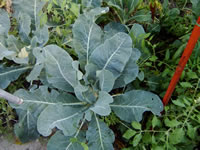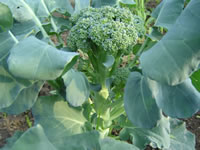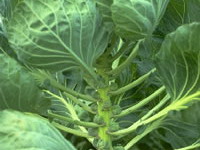|
Brassicas require regular, thorough watering but the soil should never be allowed to become soggy.
Apply a heavy layer of mulch to help control weeds and keep the soil moist and cool.
Add fertilizer prior to planting, and every four weeks during the growing season, using a high nitrogen fertilizer
or top-dress with very well-rotted manure, blood meal or guano every 4 weeks.
How to Plant and Grow Cabbage
Brassica oleracea 'Capitata' |
 |
Move starter plants to the garden as soon as the soil can be worked in the spring. Plant early varieties 12" apart and late varieties 18"-24" apart in rows spaced 24"-36" apart
There are three types of Cabbage. Green and Red Cabbages both have smooth foliage. Savoy Cabbage has crinkled green leaves. Early varieties can mature in as little as 2-3 months, but late varieties can take up to 4 months before harvest. As your Cabbage plants grow, mound soil up around the stem to support the head. Harvest when the heads are well formed and firm.
Sow seeds for a fall crop directly into the garden in April.
In USDA Zones 8 and warmer, a winter crop can be sown in early fall. |
How to Plant and Grow Cauliflower
Brassica oleracea 'Botrytis' |
 |
Move starter plants to the garden 2 weeks before the last expected frost.
Plant 15" apart in rows spaced 24"-36" apart.
Cauliflower plants that are not self-blanching can be blanched by folding and securing
the outer leaves over the heads when they are about 2" across.
Harvest while the curds are still tight by cutting the stalk below the head.
Sow seeds for a fall crop directly into the garden in May.
In USDA Zones 8 and warmer, a winter crop can be sown in late August. |
How to Plant and Grow Broccoli
Brassica oleracea 'Italica' |
 |
Move starter plants to the garden 2 weeks before the last expected frost.
Plant 24" apart in rows spaced 30"-36" apart.
Harvest just before the buds open by cutting the stem 6 " below a cluster of buds.
Your Broccoli plant will produce an extended crop of smaller heads on side branches
throughout the rest of the summer if temperatures do not get too warm.
Fertilize before planting, when the plant is 8" tall, at 15" tall,
and again when buds begin to form.
Sow seeds for a fall crop directly into the garden in late April or May. |
How to Plant and Grow Brussels Sprouts
Brassica oleracea 'Gemmifera' |
 |
Move starter plants to the garden 2 weeks before the last expected frost.
Plant 18"-24" apart in rows spaced 3 feet apart.
Mound soil up around the stem for support as the plant grows. When the sprouts begin to touch each other, remove the lower leaves, but leave the top foliage in place.
Harvest sprouts from the bottom up as they mature but are still small (1"-2").
Sow seeds for a fall crop directly into the garden in late June.
In USDA Zones 8 and warmer, a winter crop can be sown in early fall. |
Insect Pests that Attack the Cole Crops
Aside from the slugs and snails that will quickly devour seedlings and young plants,
the most common pests that attack Cole Crops are the Cabbageworm, Cabbage Loopers.
Many different types of caterpillars are known as Cabbageworm
but the European Cabbageworm is the most common and problematic.
European Cabbageworm are the larvae of the white, Cabbage Butterfly which is attracted to the Cole Crops.
Cabbageworms are light green, velvety, 1½" long caterpillars.
Cabbage Loopers are the larvae of the nocturnal Gray Moth.
They look much like the Cabbageworm, but have no middle legs so there movement is like that of an Inchworm.
Cabbageworms and Cabbage Loopers eat irregular holes through the foliage
and sometimes into the heads and stems of the Cole Crops.
Controlling Cabbageworms and Cabbage Loopers
Cabbage Butterflies and Gray Moths lay their eggs on the leaf surface and within a few days the caterpillars
hatch and begin to feed. Hand pick the caterpillars, cocoons and eggs as they are found.
Trichogramma Wasps, Yellow Jackets and Lacewings are all natural predators of these worms.
Using floating row covers to shelter your crop in early spring will lessen the chance
of a major problem for the rest of the season.
Keep the area around your Cole Crops well cultivated and clean.
Other Significant Cabbage Problems
Cabbage Root Maggots are ¼" long, white worms that live in the soil and feed
on the roots of Cole Crops, causing them to become yellow and stunted.
Beneficial Nematodes added to the soil will quickly hunt down and kill Cabbage Maggots.
Harlequin Bugs are ½" long,shiny black Stink Bugs with bright reddish orange markings.
Harlequin Bugs suck on the foliage of Cole Crops, leaving yellow blotches and eventually killing the plant.
Hand pick and squash individual bugs or use an insecticidal soap spray.
Cutworms are night feeding, hairless caterpillars that may grow up to 2" long.
They can sometimes be found curled up into a C on the soil surface during the day.
Cutworms chew through the stems of seedlings, cutting them off at ground level.
Visit the garden at night and use a flashlight to find and destroy cutworms.
Most beneficial insects are predators of Cutworms.
Spreading diatomaceous earth around seedlings will help to deter Cutworms from feeding on them.
Club Root is a soil-borne fungus that causes the roots to become misshapen and knotted.
Club Root causes the plant to slowly wilt and die.
Carefully rotate crops so that you do not plant Cole Crops in the same space for at least 2-3 years.
|




